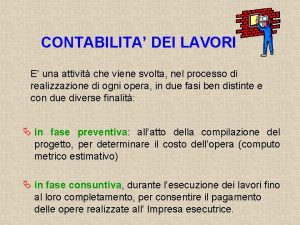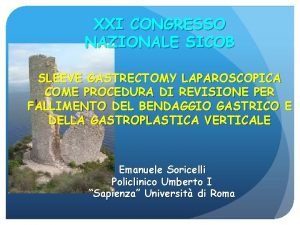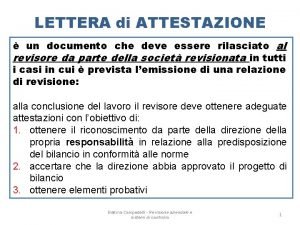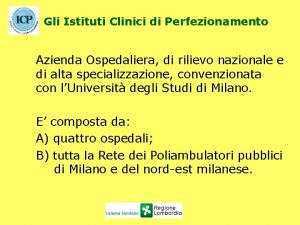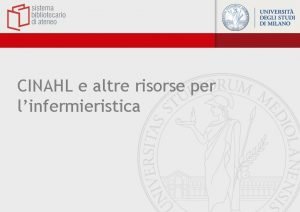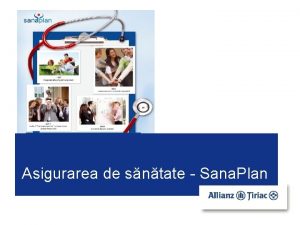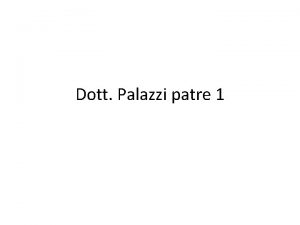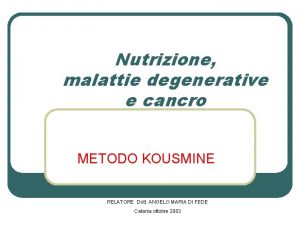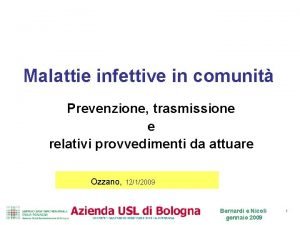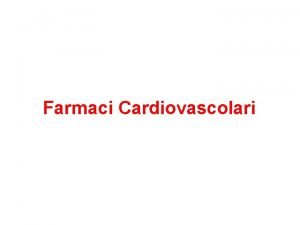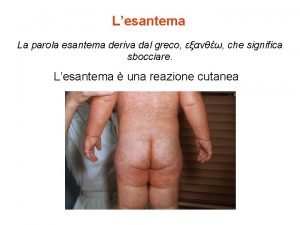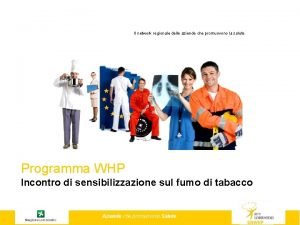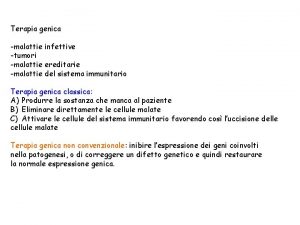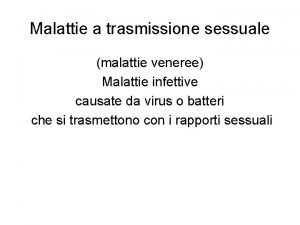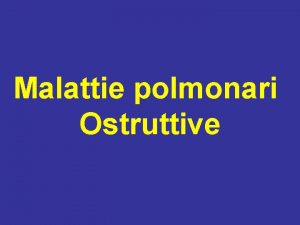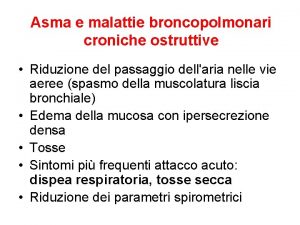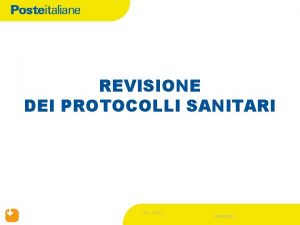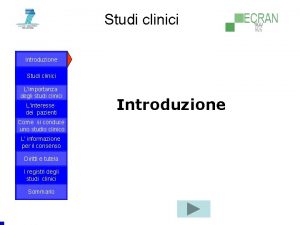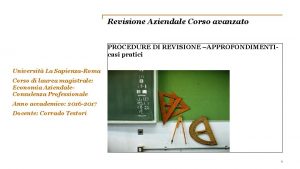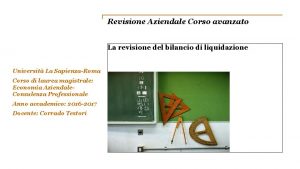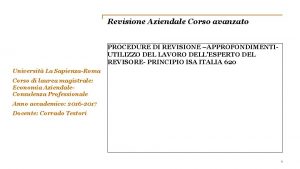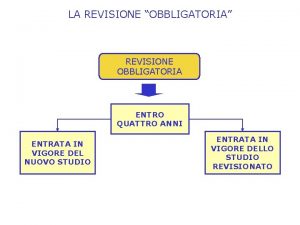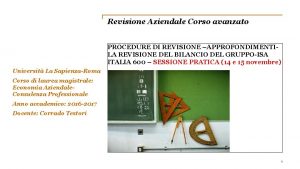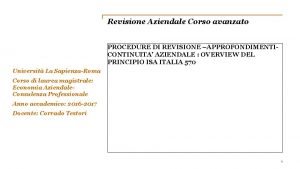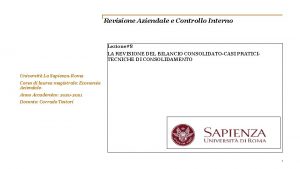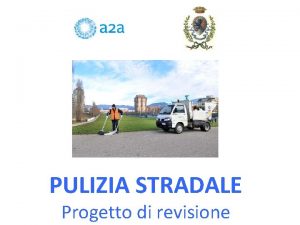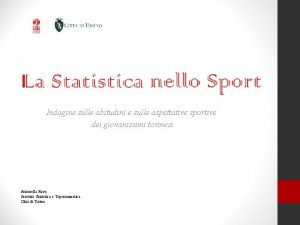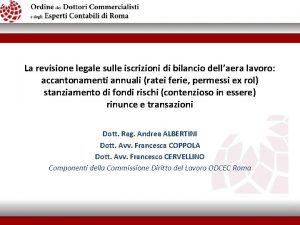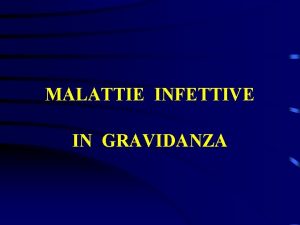Revisione dei Trial Clinici sulle Malattie Ostruttive dellultimo



























- Slides: 27

Revisione dei Trial Clinici sulle Malattie Ostruttive dell’ultimo anno Antonio Spanevello Università degli Studi dell’Insubria , Varese - Como Dipartimento di Medicina e Chirurgia Istituti Clinici Scientifici Maugeri, IRCCS, Tradate Dipartimento di Medicina e Riabilitazione Cardiorespiratoria

ASTHMA

QUADRUPLING INHALED GLUCOCORTICOID DOSE TO ABORT ASTHMA EXACERBATIONS N Engl J Med 2018; 378: 902 -10. Tricia Mc. Keever, Ph. D. , Kevin Mortimer, Ph. D. , Andrew Wilson, M. D. , Samantha Walker, Ph. D. , Christopher Brightling Ph. D. , Andrew Skeggs, B. Sc. , Ian Pavord, F. Med. Sci. , David Price, F. R. C. G. P. , Lelia Duley, M. D. , Mike Thomas, Ph. D. , Lucy Bradshaw, M. Sc. , Bernard Higgins, Ph. D. , Rebecca Haydock, B. Sc. , Eleanor Mitchell, B. A. , Graham Devereux, Ph. D. , and Timothy Harrison, M. D. The Authors tested the concept that a plan for patients to manage their asthma (self-management plan), which included a temporary quadrupling of the dose of inhaled glucocorticoids when asthma control started to deteriorate, would reduce the incidence of severe asthma exacerbations among adults and adolescents with asthma. 1871 adults and adolescents with asthma who were receiving ICS with or without add on therapy, and who had at least one exacerbation in the previous 12 months were enrolled

Zone 1 described well-controlled asthma and recommended continuation of current treatment.

Zone 2 described deteriorating asthma control and recommended increased bronchodilator medication and an increase in the dose of inhaled glucocorticoids by a factor of 4 (quadrupling group) or increased bronchodilator medication alone (non-quadrupling group).

Zones 3 and 4 described the development of an exacerbation and when to start oral glucocorticoids and seek medical interruption (zone 3) and what to do in the event of a life-threatening exacerbation (zone 4).

The primary outcome was the time to a first severe asthma exacerbation, defined as treatment with systemic glucocorticoids or an unscheduled health care consultation for asthma


The number of participants who reported a severe exacerbation of asthma in the year after randomization was 420 (45%) in the quadrupling group as compared with 484 (52%) in the non-quadrupling group, p = 0. 002

QUADRUPLING INHALED GLUCOCORTICOID DOSE TO ABORT ASTHMA EXACERBATIONS N Engl J Med 2018; 378: 902 -10. Tricia Mc. Keever, Ph. D. , Kevin Mortimer, Ph. D. , Andrew Wilson, M. D. , Samantha Walker, Ph. D. , Christopher Brightling Ph. D. , Andrew Skeggs, B. Sc. , Ian Pavord, F. Med. Sci. , David Price, F. R. C. G. P. , Lelia Duley, M. D. , Mike Thomas, Ph. D. , Lucy Bradshaw, M. Sc. , Bernard Higgins, Ph. D. , Rebecca Haydock, B. Sc. , Eleanor Mitchell, B. A. , Graham Devereux, Ph. D. , and Timothy Harrison, M. D. A total of 311 participants (33%) in the quadrupling group versus 377 (40%) in the non-quadrupling group started systemic glucocorticoids. A total of 379 participants (41%) in the quadrupling group versus 442 (47%) in the non-quadrupling group had an unscheduled health care consultation.

QUADRUPLING INHALED GLUCOCORTICOID DOSE TO ABORT ASTHMA EXACERBATIONS N Engl J Med 2018; 378: 902 -10. Tricia Mc. Keever, Ph. D. , Kevin Mortimer, Ph. D. , Andrew Wilson, M. D. , Samantha Walker, Ph. D. , Christopher Brightling Ph. D. , Andrew Skeggs, B. Sc. , Ian Pavord, F. Med. Sci. , David Price, F. R. C. G. P. , Lelia Duley, M. D. , Mike Thomas, Ph. D. , Lucy Bradshaw, M. Sc. , Bernard Higgins, Ph. D. , Rebecca Haydock, B. Sc. , Eleanor Mitchell, B. A. , Graham Devereux, Ph. D. , and Timothy Harrison, M. D. SAFETY As expected, the quadrupling group had a higher frequency of treatment-related adverse effects , such as oral candidiasis. Particular attention to the issue of pneumonia, but there was no significant between groups

QUADRUPLING INHALED GLUCOCORTICOID DOSE TO ABORT ASTHMA EXACERBATIONS N Engl J Med 2018; 378: 902 -10. Tricia Mc. Keever, Ph. D. , Kevin Mortimer, Ph. D. , Andrew Wilson, M. D. , Samantha Walker, Ph. D. , Christopher Brightling Ph. D. , Andrew Skeggs, B. Sc. , Ian Pavord, F. Med. Sci. , David Price, F. R. C. G. P. , Lelia Duley, M. D. , Mike Thomas, Ph. D. , Lucy Bradshaw, M. Sc. , Bernard Higgins, Ph. D. , Rebecca Haydock, B. Sc. , Eleanor Mitchell, B. A. , Graham Devereux, Ph. D. , and Timothy Harrison, M. D. CONCLUSIONS A temporary quadrupling of the dose of inhaled glucocorticosteroids when asthma control started to deteriorate resulted in fewer severe asthma exacerbations than a plan in which the dose was not increased.

DISCUSSION The main strength of our trial is its pragmatic design and 80% recruitment in primary care, giving it considerable external validity. Broad inclusion criteria ensured that the trial results are applicable to adult patients with a clinical diagnosis of asthma who are taking any licensed dose of inhaled glucocorticoids, with or without add-on medication and regardless of smoking status. We minimized trial visits after training participants to follow a personalized self-managemente plan to reflect follow-up in clinical practice.

DISCUSSION Our finding that approximately 50% of the patients included in the trial had an exacerbation, within a year, that led to treatment with oral glucocorticoids or an unscheduled health care consultation confirms that our inclusion criteria identified a group of patients at high risk for an asthma exacerbation and is consistent with generally poor asthma control reported in many asthma surveys.

COPD

URTI: viral upper respiratory infections

Stolz D, et al. Rationale A growing body of evidence implicates viral respiratory tract infections as the predominant risk factor associated with exacerbations of COPD and the development of chronic airway disease.

Stolz D, et al. Rationale Combination therapy with high-dose inhaled corticosteroids ICS) and long-acting β 2 agonists (LABA) reduces the incidence of acute exacerbations in COPD. However, high dose maintenance ICS have been associated with pneumonia. Thus, reduction of ICS exposure to the minimum required for preventing exacerbations is a goal in the management of COPD.

Stolz D, et al. Rationale In asthma, a flexible regimen of ICS and LABA “on-demand” in patients on low maintenance ICS/LABA significantly reduces steroid exposure while leading to a decrease in asthma exacerbation rate as compared to a fix regimen of high maintenance dose ICS/LABA.

Stolz D, et al. The primary objective of the present study was to investigate whether intensified combinations therapy with ICS/LABA at the onset of URTI could reduce exacerbations in patients with COPD receiving low maintenance dose ICS/LABA.

Stolz D, et al. At inclusion, all patients were assigned to open-labelled low maintenance dose of ICS/LABA (budesonide 200 μg/formoterol 6 μg, twice-daily), which was continued for the whole duration of the study. Each patient was block-randomized 1: 1 to receive the investigational medicinal product (IMP) as an inhaler intensified dosage of the cmbination ICS/LABA (budesonide 400 μg/formoterol 12 μg) or placebo. Patients were instructed to keep the IMP at home and to start using the IMP only in case of an URTI symptoms (stuffed or running nose, sniffle, sneeze) for at least 12 h twice daily, for 10 days.

Stolz D, et al. The primary outcome measure was the number of patients that had an exacerbation occurring within 21 days after the onset of a URTI. The secondary outcome measures were: (a) number of patients that required hospital admission of any cause within 21 days after URTI onset; (b) change in symptoms scores and lung function parameters; (c) exposure to steroids and antibiotics within 21 days of URTI.

ANY EXACERBATION The proportion of patients developing any exacerbation following an URTI was 14, 58% in the ICS/LABA group as compared to 16, 20% in the placebo group (P = , 312).

SEVERE EXACERBATIONS The percentage of patients who developed a severe exacerbation of COPD within 21 days of an URTI was significantly lower in the ICS/LABA group (2, 1%), as compared to the placebo group (6, 6%). P = , 010.


ICS/LABA significantly decreased the risk of any exacerbation in patients: (a) with severe airflow obstruction, i. e. GOLD stage 3 and 4; (b) with higher risk, i. e. GOLD groups C and D; (c) with (BODE ≥ 2 points) and (d) with higher exhaled nitric oxide.

Stolz D, et al. CONCLUSIONS Intensified combination therapy with ICS/LABA for 10 days at URTI onset did not decrease the incidence of any COPD exacerbation but prevented severe exacerbation. Patients with more severe disease had a significant risk reduction for any exacerbation.
 Lavori in economia contabilità
Lavori in economia contabilità Revisione tra pari
Revisione tra pari Sicob sleeve gastrectomy
Sicob sleeve gastrectomy Lettera di attestazione fac simile
Lettera di attestazione fac simile Gastroscopia celiachia
Gastroscopia celiachia Istituti clinici di perfezionamento
Istituti clinici di perfezionamento Esempi quesiti clinici pico infermieristica
Esempi quesiti clinici pico infermieristica Parteneri allianz asigurare medicala
Parteneri allianz asigurare medicala Malattie epifitiche
Malattie epifitiche Malattie multifattoriali esempi
Malattie multifattoriali esempi Malattie croniche
Malattie croniche Kousmine malattie autoimmuni
Kousmine malattie autoimmuni Malattie
Malattie Malattie epifitiche
Malattie epifitiche Malattie cardiovascolari
Malattie cardiovascolari Malattie dismielinizzanti
Malattie dismielinizzanti Enantematico
Enantematico Fioretta del vino
Fioretta del vino Malattie croniche
Malattie croniche Cromatidio
Cromatidio Agnus dei qui tollis peccata mundi
Agnus dei qui tollis peccata mundi Testo narrativo sui diritti dei bambini
Testo narrativo sui diritti dei bambini Cosa sono le proiezioni in geometria
Cosa sono le proiezioni in geometria Poesia eroica saba
Poesia eroica saba Le origini della letteratura latina mappa concettuale
Le origini della letteratura latina mappa concettuale Non sa più nulla è alto sulle ali analisi
Non sa più nulla è alto sulle ali analisi Marie curie mappa concettuale
Marie curie mappa concettuale Schema riassuntivo sulle forze
Schema riassuntivo sulle forze
